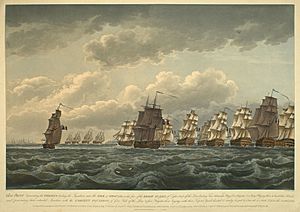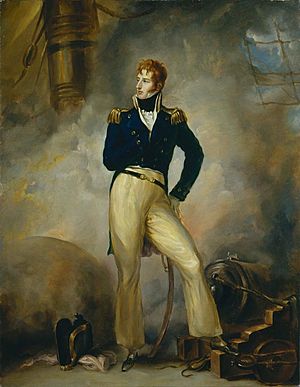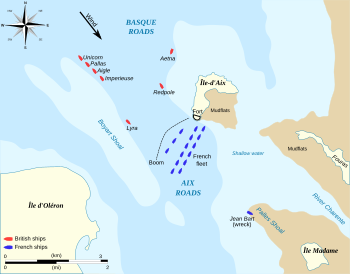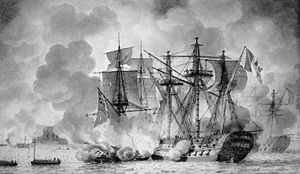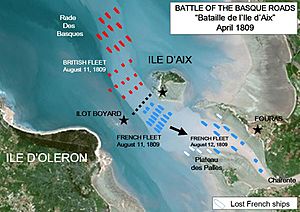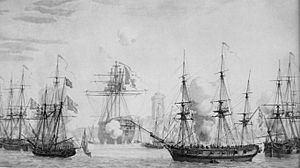Battle of the Basque Roads facts for kids
Quick facts for kids Battle of the Basque Roads |
|||||||
|---|---|---|---|---|---|---|---|
| Part of the Napoleonic Wars | |||||||
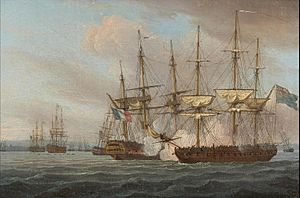 Destruction of the French Fleet in Basque Roads, Thomas Whitcombe |
|||||||
|
|||||||
| Belligerents | |||||||
| Commanders and leaders | |||||||
| Strength | |||||||
|
|
||||||
| Casualties and losses | |||||||
| 43 killed and wounded |
|
||||||
The Battle of the Basque Roads, also known as the Battle of Aix Roads, was a big naval battle during the Napoleonic Wars. It happened from April 11 to 24, 1809, in the narrow waters of the Basque Roads, near the French coast. This battle was unusual because a small, special British fleet attacked the main French Atlantic Fleet in shallow, tricky waters. The battle also became famous for the arguments and political drama that followed in both Britain and France.
In early 1809, the French Atlantic Fleet was stuck in Brest because the British Channel Fleet was blocking them. The French tried to escape into the Atlantic to help their forces in Martinique. British ships spotted and chased them. The French couldn't get out of the Bay of Biscay and ended up anchoring in the Basque Roads, near the naval base of Rochefort.
During March, the British fleet, led by Admiral Lord Gambier, watched the French. The British government wanted an attack. They ordered Lord Cochrane, a brave and popular captain, to lead it. Many senior officers didn't like this idea. Cochrane put together a special group of fireships (ships filled with burning materials) and bomb vessels (ships that fired bombs). He personally led this force into Basque Roads on the evening of April 11.
The attack didn't cause much direct damage at first. But in the narrow waters, the fireships scared the French sailors. Most of their ships ran aground and got stuck. Cochrane expected Gambier to follow up with the main British fleet to destroy the helpless French ships, but Gambier refused. Cochrane kept fighting for several days, sinking some French ships, but he got little help from Gambier. This allowed most of the French fleet to float free and escape up the Charente River to safety. Gambier called Cochrane back on April 14 and sent him to Britain. Most of the special attack ships were also pulled back, though small fights continued until April 24. The French fleet was badly damaged and trapped in its home ports. Several French captains were punished for their actions, and one was executed.
In Britain, the battle was seen as a victory. But many in the Navy were unhappy with Gambier. Cochrane, who was also a Member of Parliament, publicly complained about Gambier's leadership. Gambier then asked for a special hearing to clear his name. His political friends made sure the hearing was fair to him. After many arguments, Gambier was found innocent. Cochrane's naval career suffered, but he remained a well-known person in Britain for many years. Most historians today believe Gambier failed to properly support Cochrane. Even Napoleon called Gambier an "imbécile" (a fool).
Setting the Scene
By 1809, the Royal Navy was very powerful in the Atlantic. After big battles in 1805 and 1806, the French Atlantic Fleet had lost many ships. The remaining French ships were trapped in French ports on the Biscay coast. The British Channel Fleet kept a close watch on them.
The biggest French naval base was at Brest. The main French fleet was there, led by Admiral Jean-Baptiste Philibert Willaumez. Smaller French groups were at Lorient and Rochefort. Admiral Lord Gambier led the British fleet watching Brest. Gambier was not very popular. He was known for being the first captain to break the French line in a battle in 1794. Later, he worked mostly in naval administration. He was given the title Baron Gambier for leading the fleet at the Bombardment of Copenhagen in 1807. Gambier was a very religious man, and his sailors called him "Dismal Jimmy."
French Fleet on the Move
British control of the seas allowed the Royal Navy to attack French colonies, especially the rich ones in the Caribbean. In late 1808, the French found out that Britain was planning to invade Martinique. So, Admiral Willaumez was ordered to take his fleet to sea. He was supposed to meet up with the ships from Lorient and Rochefort to help Martinique.
Gambier's fleet was blocking Brest. Willaumez could not move until winter storms forced the British ships to leave in February 1809. Willaumez then sailed south on February 22 with eight large warships and two smaller ones. Captain Charles Paget on HMS Revenge was watching Brest. He saw the French ships and knew where they were going.
The British ships watching Lorient were HMS Theseus, HMS Triumph, and HMS Valiant. They were led by Commodore John Beresford. Paget warned Beresford about the French fleet. Beresford's ships saw Willaumez's fleet sailing southeast. Willaumez sent four of his ships to chase Beresford away. Beresford turned northwest, clearing the way to Lorient. Willaumez then anchored his fleet near the island of Groix.
On February 23, Willaumez sent a small ship to Lorient. It carried orders for Admiral Amable Troude to sail his ships to the Pertuis d'Antioche near Rochefort. This was where the French fleet was supposed to gather. Willaumez then took his fleet south, with Beresford's ships following. The French fleet passed several islands and was seen by HMS Amethyst. This ship was scouting for the British Rochefort blockade squadron, led by Rear-Admiral Robert Stopford. Amethyst fired signal rockets to warn Stopford. Stopford's ships got closer to Willaumez during the night. But they were not strong enough to stop the French from entering the Basque Roads on the morning of February 24.
British Blockade and French Defenses
Stopford sent HMS Naiad to warn Gambier. Gambier had already found the French fleet missing from Brest. He sent eight ships south to stop any French attempt to enter the Mediterranean. Gambier then took his flagship, HMS Caledonia, to Plymouth for more ships. Naiad found Caledonia and gave Gambier Stopford's message. Gambier returned to the Bay of Biscay with four more ships. By March 7, he had a fleet of 13 ships, later reduced to 11.
Shortly after leaving Stopford's group, Naiad saw three French frigates approaching. These ships had sailed from Lorient to join Willaumez. British frigates had been watching them. The French frigates were trapped between two British forces. Their commander took them close to shore under the guns of Les Sables d'Olonne. Stopford followed and attacked them. In the battle, all three French ships were damaged and ran aground beyond repair.
Willaumez did not try to fight Stopford or Gambier. He had successfully joined with the Rochefort ships, which included three warships, two frigates, and a captured British supply ship. The French fleet now had 11 warships. They moved from the open Basque Roads into the narrow channel near Île-d'Aix, called the Aix Roads. These waters offered more protection but were also very dangerous. On February 26, as the French moved into shallower waters, the warship Jean Bart ran aground and was wrecked.
The channel where Willaumez placed his fleet was a strong defensive spot. Any attacker had to cross the open Basque Roads and pass a hidden, dangerous sandbar called the Boyart Shoal. Then, the attacking force would face fire from forts on Île-d'Aix before reaching the French fleet. This anchorage had been attacked successfully before in 1757, but more recent attempts had failed.
There was unhappiness among the French fleet. Many thought Willaumez should have attacked Stopford when he had more ships. Captain Jacques Bergeret even wrote a letter criticizing Willaumez to the French Navy Minister. He warned that the Aix Roads could be attacked by the British. The Minister removed Willaumez and replaced him with Zacharie Allemand on March 16. News arrived that the British had captured Martinique, so Allemand prepared his defenses.
The French strengthened their position with a heavy boom (a barrier of chains and tree trunks) between the Boyart Shoal and Île-d'Aix. This boom was long and wide, held in place by heavy anchors. The British didn't even notice it. More than 2,000 French soldiers were placed on Île-d'Aix, with many cannons. Allemand also ordered his captains to arrange their ships in a special way. They formed two alternating lines across the channel. This meant that any attacking ships would face fire from several French ships at once. The frigates were placed between the main fleet and the boom.
In the British fleet, there was much talk about how to attack the French. Gambier worried that French fireships might attack his fleet. He told his captains to be ready to leave quickly if they saw such an attack. He also wrote to the Admiralty in London, suggesting that British fireships be prepared. But he warned that it was a "horrible mode of warfare" and very risky. Several officers, like Rear-Admiral Eliab Harvey, offered to lead such an attack. But Gambier hesitated. He didn't check the water depths or make any real plans for an assault.
Cochrane Takes Command
Since Gambier was slow to act, the head of the British Admiralty, Lord Mulgrave, stepped in. The British Prime Minister wanted the French fleet destroyed because it threatened British colonies. So, on March 7, ten fireships were ordered to be made ready. Mulgrave then made a very surprising choice for who would lead the attack.
On March 11, HMS Imperieuse arrived at Plymouth. Its captain, Lord Cochrane, was told to go straight to the Admiralty. Cochrane was a bold and outspoken officer. He was famous for capturing a much larger Spanish ship with his small brig in 1801. In his frigates, he had caused a lot of trouble for the French and Spanish by attacking their ships and defenses, especially near Rochefort. He was also a very active politician, elected as a Member of Parliament in 1807. He often criticized the government.
At his meeting with Mulgrave, Cochrane explained a plan he had made years ago to attack Basque Roads. He excitedly described using fireships and huge floating bombs to destroy a fleet. When he finished, Mulgrave announced that the plan would go ahead, and Cochrane would lead it. Cochrane was not well, and he knew Mulgrave's intentions: if the attack failed, Cochrane would be blamed, and his political career would be hurt. He also knew this decision would make many senior naval officers angry. Giving such an important job to a junior officer was sure to cause offense. Cochrane refused the command. Mulgrave begged him, saying Cochrane was the only officer with a practical plan. Cochrane still refused. But the next day, Mulgrave gave a direct order: "My Lord you must go."
Cochrane immediately returned to Imperieuse. The frigate then sailed to join Gambier's fleet. Gambier had received orders from Mulgrave on March 26 to prepare for an attack. Gambier wrote back, agreeing with the order but also arguing against it. He said the water was too shallow and the forts on Île-d'Aix were too dangerous. Gambier didn't know Cochrane would lead the attack until Cochrane arrived on April 3 and showed him Mulgrave's orders.
This caused a big reaction. Rear-Admiral Eliab Harvey, a hero from the Battle of Trafalgar, became very angry. He yelled at Gambier, calling him incompetent and comparing him badly to Nelson. He called Cochrane's appointment an "insult to the fleet." Gambier sent Harvey and his ship back to Britain in disgrace. Then, he ordered Cochrane to start preparing the attack. Gambier also gave Cochrane religious pamphlets to give to his crew. Cochrane ignored this order but sent some pamphlets to a journalist friend, who wrote articles that later caused problems for Cochrane.
The Night Attack
Cochrane's Bold Plan
The 18 fireships ordered by Mulgrave from Britain had not arrived when Cochrane joined the fleet. So, Cochrane spent the next week preparing his own. He took eight military transport ships and loaded them with tar and resin, which were perfect for burning. The frigate-supply ship HMS Mediator became the main part of the attack force. These ships were filled with explosives and flammable materials like hay soaked in rum. Volunteers from the fleet manned them.
On three of the ships, Cochrane loaded 1,500 barrels of gunpowder. On top of that, he put hundreds of artillery shells and thousands of grenades. This created an "explosion ship," a floating bomb designed to blow up right in the middle of the French line. During these preparations, French boats tried to attack the fireships but were driven off. On April 5, Cochrane explored the waters near Aix Roads. He fired shots at the forts and the French fleet to see how they would react. He later suggested to Mulgrave that with 20,000 soldiers, he could capture the defenses and block the channel. This would permanently take away one of France's most important naval bases. But his idea was ignored.
On April 6, HMS Aetna, a ship with a heavy mortar, arrived with William Congreve. Congreve had invented a rocket artillery system that would be used in the attack. On April 10, the first group of 12 fireships arrived. This gave Cochrane a total of 24 fireships and explosion vessels. These ships also carried thousands of Congreve rockets. The rockets were tied to the masts and yards of the fireships to fire in all directions as the ships burned.
Cochrane was apparently unaware of the French boom because Gambier had not scouted the channel well. Cochrane planned for his force, led by the heavy Mediator and the explosion vessels, to enter the anchorage at night. He hoped to cause confusion among the French fleet. The goal was to destroy some French ships by fire and drive others ashore. Then, the British fleet would attack and destroy or capture the rest.
Allemand could see the fireships being prepared in Basque Roads. He strengthened his defenses by placing 73 small boats along the boom. These boats were meant to tow fireships away from the French fleet onto the mud flats. He also ordered all his warships to remove their sails and topmasts. This made them mostly unable to move but much less likely to catch fire. The frigates kept their rigging so they could move if a major attack happened.
Cochrane finished his preparations and ordered the attack for the evening of April 11. Gambier was hesitant to let his sailors help Cochrane. He said, "if you choose to rush to self-destruction that is your own affair . . . but it is my duty to take care of the lives of others." Cochrane was furious. After a heated argument, Gambier finally gave permission. He placed Imperieuse near the Boyart Shoal, about 2.5 kilometers from the French fleet. This ship, along with other frigates, would pick up the crews of the fireships as they abandoned their burning vessels. Smaller ships were used to guide the fireships into the channel. Other ships were equipped with rockets. Gambier, with the main fleet, moved closer to the entrance of Aix Roads but stayed about 9 kilometers away. Some historians think he did this so he could easily retreat if the French attacked.
Fireships Attack
As night fell, the wind was too strong to chain the fireships together as planned. Each ship had to act on its own. At 8:30 PM, with the wind and tide in their favor, the fireships silently sailed towards the French fleet. Most of the volunteer crews lit their ships and left them too early. The blazing ships ran aground long before reaching the boom. One even threatened Imperieuse, which had to move to avoid being destroyed. Other crews lost control of their ships and didn't take part in the attack.
However, a few ships, including the lead explosion ship commanded by Cochrane himself, continued forward quickly as the wind grew stronger. Cochrane waited until the last minute to light his own ship. His escape boat was still near the explosion when the ship blew up, but he was unharmed. Elsewhere, five British sailors were killed and six wounded in early explosions. The explosion ships blew up near the French frigate Indienne around 9:30 PM and 9:40 PM. They were stopped by the boom and did little damage. But then Mediator followed, smashing a hole in the boom. The few remaining fireships passed through this hole.
Allemand's boat crews couldn't stop Cochrane's ships because the sea was too rough. The fireship crews had great difficulty returning to the British ships. The Aix Road became a scene of "sublime horror." Blazing fireships drifted randomly among the huge French warships. Shells from Aetna and thousands of rockets exploded, adding to the confusion. The forts and all ships fired their guns at anything they saw or imagined.
The fireships reached the French frigate line at 9:45 PM. The frigates cut their anchor cables and retreated southeast down the channel. The blazing ships then hit the French line. Régulus was hit, and its crew fought for 15 minutes to push the fireship away. The drifting warship then crashed into Tourville. Cassard was also badly hit, losing 20 men. Several other French ships were badly damaged in the chaos.
At 10:00 PM, while avoiding three drifting fireships, the huge 120-gun French flagship Océan ran aground. It was badly burned by a fireship that hit its stern. To prevent an explosion, the crew opened valves and flooded the gunpowder room. As they struggled, the drifting Tonnerre and Patriote appeared out of the darkness. Patriote turned away in time, but Tonnerre crashed into the side of the flagship, causing damage. Océan's crew held the burning ship close long enough for the other drifting ships to escape. Then they released the fireship to drift ashore. During this effort, at least 50 men fell to their deaths into the fiery gap between the ships.
Gambier's Delay
| "This would have been the time to have destroyed them; but this favourable opportunity was neglected, which caused not a little murmuring among us, and was considered most unseamanlike by many experienced men in the fleet." |
| James Choyce, fireship volunteer |
As dawn broke on April 12, only Cassard and Foudroyant were still floating. They had drifted into the mouth of the Charente River with the tide. The other nine warships, the supply ship Calcutta, and four frigates were all stuck on the mud and rocky shoals of the channel. Océan was alone on the mud. Ville de Varsovie and Aquilon were stuck on rocks nearby. Régulus and Jemmapes were on softer ground. To the north, Tonnerre was stuck hard near Île Madame. Despite the crew's efforts, it had already filled with water and was completely wrecked. Calcutta lay on the Palles Shoal. Patriote and Tourville were stuck near the mouth of the Charente.
Cochrane, back on Imperieuse, immediately saw a chance to destroy the French fleet. The French ships were stuck and helpless. They could be easily destroyed by a strong attack on the Aix Roads. Only the forts and two floating ships could resist. At 5:48 AM, he urgently signaled Gambier: "Half the fleet could destroy the enemy." Gambier received the message but gave no reply or orders. As the French ships began to move with the tide, Cochrane sent more signals: "Eleven on shore" at 6:40 AM, and "Only two afloat" at 7:40 AM. Still, no response from the distant British fleet.
At 9:30 AM, Cochrane signaled that the "Enemy preparing to heave off" as French crews began trying to refloat their ships. Cochrane sent more signals, like "Two sail of the line are enough" and "the frigates alone can destroy the enemy." The first was not sent because the signal officer thought it would insult Gambier. The second was sent but not recorded in Gambier's ship's logbook. At 9:35 AM, Gambier ordered his fleet to prepare to move, then changed his mind. Instead, he held a meeting with his captains on his flagship. Finally, the fleet sailed at 10:45 AM. But at 11:30 AM, Gambier stopped after only 3 kilometers. He anchored the ships again near Île-d'Aix and continued his meeting. Gambier avoided any signal that might show he planned an attack. His actions at this point have been called "one of the most contemptible acts of any commander-in-chief in British naval history" by one historian.
While Gambier hesitated, the French ships that had run aground slowly began to float free. Some got stuck again. Because they had removed their topmasts before the attack, they were less damaged and easier to move. Foudroyant and Cassard, fearing a British attack, retreated up the Charente River at 12:45 PM. Both then ran aground at Fouras. At 1:00 PM, Cochrane, growing very impatient, deliberately let Imperieuse drift alone towards the French fleet. He flew signals like "The enemy's ships are getting under sail" and "the ship is in distress, and requires to be assisted immediately." He later wrote that it was better to risk his ship or even his career than to let the Admiralty's hopes end in disgrace.
At 2:00 PM, Imperieuse was close enough to Calcutta and began firing steadily at the stuck supply ship. Aetna and several smaller ships supported him. Cochrane ordered them into position by firing cannons in their direction until they moved where he wanted. Cochrane had forced Gambier's hand. Despite wanting to avoid fighting, Gambier could not let one of his frigates fight the entire French fleet alone. He reluctantly ordered several large frigates and two warships, Valiant and Revenge, to join Cochrane's group. They were to enter the Aix Roads and support him.
Cochrane's Continued Fight
British Reinforcements Arrive
British reinforcements entered Basque Roads at 3:20 PM. Just then, the crew of Calcutta abandoned their ship. The British ships formed a line and began firing heavily at the nearby, still-stuck Ville de Varsovie. A smaller British ship, Beagle, got very close and fired repeatedly into the front of Aquilon. For two hours, these stuck French ships were hit by British fire with little response. At 5:30 PM, both raised white flags, showing they had surrendered.
Shortly after, the crew of the wrecked Tonnerre abandoned their ship and set it on fire. The French ship was destroyed by a huge explosion at 7:30 PM. At 8:30 PM, Calcutta also exploded. It had been mistakenly set on fire by an overly eager British boarding party. The supply ship was carrying a lot of ammunition, reportedly worth a huge amount of money, and caused a massive blast. Most British ships had only minor damage and few casualties from the French forts on Île-d'Aix. Revenge had temporarily run aground during the night and had 18 casualties. French losses were small, except on Ville de Varsovie, which had about 100 casualties.
Gambier did not want to risk his fleet in the narrow waters. But he allowed three more transport ships to be made into fireships. At 5:30 PM, Stopford led these into the anchorage with his ship Caesar and other vessels. However, at 7:40 PM, Caesar ran aground on a sandbar and was stuck until 10:30 PM. Six French ships remained stuck near the mouth of the Charente. The rest of the French fleet had escaped upriver to safe anchorages. During the night, the wind made a fireship attack impossible. So, the British focused on setting Ville de Varsovie and Aquilon on fire. These ships were too damaged to be saved. During this operation, one of the new fireships was wrecked on a sandbar. The weather was so bad that night that the planned attack with the remaining fireships was canceled.
The sight of the burning wrecks at night again caused panic in the French fleet. The stuck French ships fired heavily at the burning ships, thinking they were fireships. Captain Lacaille of Tourville was so scared that he immediately ordered his crew to abandon ship and set it on fire. The evacuation was so rushed that the fires didn't spread well. The next morning, the ship was found to be mostly intact. The crew returned to their ship. They found that one quartermaster had stayed on board. He had single-handedly fought off a British boat trying to capture the ship. During the night, about 30 sailors joined him, keeping Tourville in French hands until dawn.
Battle Continues
At 5:00 AM on April 13, Stopford ordered the special attack squadron to return to Gambier's fleet. Cochrane was furious again. He even suggested taking Imperieuse and another frigate on a desperate attack on the still-stuck Océan. But the captain of the other frigate refused. Frustrated, Cochrane stayed in the anchorage with a few smaller ships. At 8:00 AM, he ordered a new attack on the remaining stuck ships at the mouth of the Charente. By 11:00 AM, the small ships were in position and opened fire on the French flagship. Although Aetna's gun broke, forcing it to leave, the firing continued all day with little effect. It wasn't until 4:00 PM that the damaged Océan and Régulus, having thrown most of their supplies overboard, could safely retreat towards the Charente.
During this fight, three small rocket ships reached Cochrane from the main fleet. Gambier had sent a two-part letter. The first part praised Cochrane's achievements and urged him to attack Océan again, but said Gambier thought success was unlikely. The second part, a private letter, allowed one more attack but ordered him to withdraw that evening. Gambier wanted to "send you to England as soon as possible." Cochrane replied to the first part, saying he would attack again the next day, and ignored the second part. Cochrane later claimed that Gambier had directly ordered him to withdraw by signal, but there is no proof of such a signal.
Cochrane Withdraws
During the night, the British did not attack again. The next morning, they found that most of the French ships had successfully retreated up the Charente. Océan and Tourville were still reachable, both stuck again near Foures. A few other French ships could still be hit by long-range fire. At 9:00 AM, Gambier gave a clear signal ordering Cochrane to withdraw and replaced him with George Wolfe as commander. Cochrane reluctantly returned to the fleet and had an angry meeting with Gambier. He accused the admiral of "extraordinary hesitation" and urged a new attack. Gambier refused and warned Cochrane that if he tried to blame Gambier, he would be seen as "arrogantly claiming all the merit to yourself." Cochrane was immediately ordered to return to Britain, sailing on April 15. Wolfe briefly continued the attack on April 14 with a repaired Aetna, using all its ammunition with little effect.
At 2:00 AM on April 15, Océan finally started moving again, reaching safety upriver by 3:30 AM. Several other ships were exposed, but without a bomb vessel, they were out of range of the British fleet. French sailors worked hard to save these ships over the next few days. On April 16, Indienne was too damaged to be saved, so it was abandoned and set on fire. The frigate exploded at midday. The next day, Foudroyant and Tourville reached safety. Only Régulus remained vulnerable. For several days, in bad storms and heavy rain, the ship stayed stuck in the mud. Wolfe tried to bring up a newly arrived bomb vessel, HMS Thunder. An attack on April 20 failed after the gun broke. A larger attack with both bomb vessels and smaller ships failed on April 24. No more attempts were made to destroy Régulus. On April 29, the ship finally floated free and was brought to safety in the Charente. On the same day, Gambier finally ended his blockade of the river and sailed his fleet for England.
Aftermath
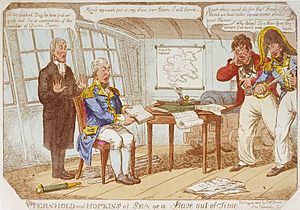
The battle was clearly a victory for the British. Three French warships, a fourth-rate ship, and a frigate were destroyed. Most of the remaining French fleet was badly damaged and needed many repairs. French casualties are not known for sure, but are thought to be around 150–200. British losses were only 13 killed and 30 wounded.
Admiral Allemand later wrote that the most significant damage from the battle was to the French fleet's morale. He said that "the greater part are disheartened; every day I hear them lamenting their situation, and speaking in praise of their enemy." Another French person told a British officer that French sailors "had now no security from the English in their harbours." No British ships suffered more than minor damage. The British fleet could return to its blockade knowing that the French fleet at Brest was out of action for some time. This was the last time during the Napoleonic Wars that a major French fleet could sail from the Atlantic ports. Without naval support, the French colonies in the Caribbean were cut off, blocked, invaded, and captured soon after.
Punishments and Rewards
The battle also led to serious legal issues. In France, four captains faced special hearings starting June 21. They were accused of abandoning their ships too easily and not following orders. The captain of Tonnerre was found innocent. The captain of Indienne was found innocent of the first charge but given three months of house arrest for the second. The captain of Tourville was sentenced to two years in prison and removed from the Navy for abandoning his ship too early. The captain of Calcutta, Jean-Baptiste Lafon, was found guilty of abandoning his ship in the face of the enemy and sentenced to death on September 8. He was executed the next day. Historian Richard Woodman believes these officers paid the price for the earlier hesitation of Admiral Willaumez.
In Britain, Cochrane arrived on April 21, and news of the victory spread quickly. Newspapers reported dramatic accounts of the battle, leading to national celebrations. The junior officers involved in the fireship attack were promoted and given money. James Wooldridge, captain of Mediator, who was badly burned, received a gold medal and a special sword. Later, in 1847, the Admiralty gave a special medal to the 529 surviving people from the battle.
Cochrane was at first celebrated for his achievement. He was made a Knight Companion on April 26. But soon after, he told Lord Mulgrave that he planned to use his position as a Member of Parliament to oppose any effort to thank or reward Gambier for his part in the battle. Mulgrave immediately warned Gambier, who then demanded a special hearing to investigate his actions. The hearing began on July 26. The panel was led by Admiral Sir Roger Curtis and William Young, both friends of Gambier and political opponents of Cochrane. Over eight days, witnesses were called, and evidence was presented. Much of it was misleading. For example, the maps of Basque Roads used in court were drawn by officers from Gambier's ship and supported his version of events. Cochrane was questioned aggressively and lost his temper several times. In the end, Gambier was found innocent and received thanks from Parliament, despite Cochrane's strong opposition.
Gambier remained in command until 1811 and served until his death in 1833. Cochrane faced difficulties in his career and chose to focus on his political goals. He later joined the navies of Chile, Brazil, and Greece during their wars for independence. He was returned to the Royal Navy in 1832 and died in 1860.
What Historians Say
Historians have debated who was to blame for the French defeat. Some blame Willaumez's hesitation in February. Others blame Allemand for trying to fortify his fleet's anchorage instead of trying to escape or counter-attack. Once he decided to stay anchored in Aix Roads, a British attack became unavoidable.
In Britain, historians have criticized Gambier's actions ever since the battle. For example, William Laird Clowes wrote in 1901 that the battle was "mismanaged by the Admiralty at home and by the Admiral on the spot." He also said that "a great naval commander never loses an occasion to attack when conditions are favourable to him." In 2007, Noel Mostert wrote, "Oh Nelson! Nelson, Nelson, where were you?" He meant that Nelson's strong leadership was greatly missed. David Cordingly wrote in the same year that the attack's boldness was like that of famous commanders like Drake and Nelson. Yet, he said the action at Basque Roads is seen as a "wasted opportunity, a bungled and confused affair." Perhaps the strongest criticism came from an enemy. Years later, Napoleon wrote that Cochrane "could not only have destroyed [the French ships], . . . but he might and would have taken them out, had your admiral supported him as he ought to have done . . . The French admiral was a fool, but yours was just as bad."
See also
 In Spanish: Batalla de la isla de Aix para niños
In Spanish: Batalla de la isla de Aix para niños


